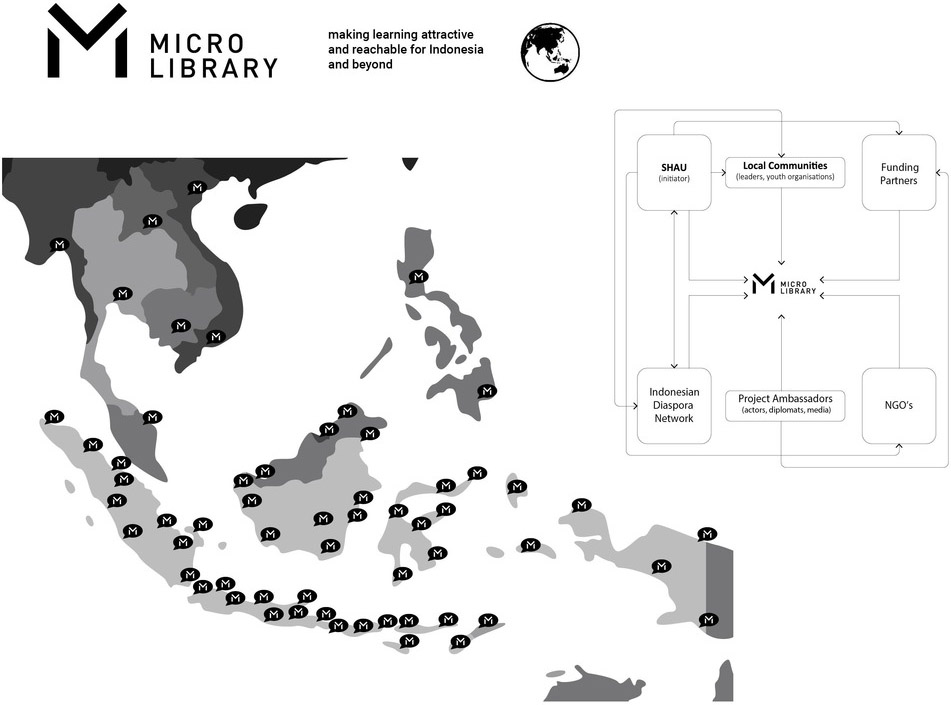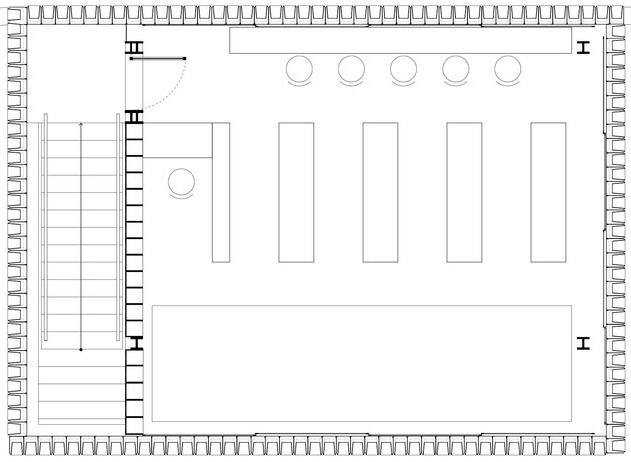印度尼西亚的文盲率很高,缺乏阅读设施。有鉴于此,曾荣获多项殊荣的SHAU事务所启动了一个特殊项目:通过为多个社区活动提供阅读场所来重新提高人们对于书籍的兴趣。
With high illiteracy rate in Indonesia and lack of reading facilities, SHAU -a multi-awarded rising architecture practice- started a mission: to rekindle interest in books by offering a designed place for reading paired with multiple community activities.
▼由两千个回收冰淇淋桶组成的图书馆,the Microlibrary Bima made out of 2000 recycled ice cream buckets
微型图书馆:小而多,从万隆到南半球
Microlibraries: Small but Many, From Bandung to the Global South
2012年,“100微型图书馆”计划的启动惠及了整个印度尼西亚及周边国家。它使得学习变得更轻松而有趣。虽然印度尼西亚的经济预测乐观,但目前的基础设施尚无法满足改善国家人类发展指数的需要。热心学习的学生缺乏活动场所,而图书馆又缺乏吸引力。美好的设计可以改变这一切,让图书馆变得更佳吸引人。除了设在市中心,甚至还可以设在家附近。
In 2012, the ‘100 Microlibraries’ program was initiated to make learning attractive and reachable for Indonesia and beyond. Although the economic forecast for Indonesia is optimistic, the current infrastructure does not support to improve its Human Development Index. Eager-learning students are hindered by the lack of facilities; libraries are far from being popular. The role of beautiful design can make libraries attractive again. Instead of positioning libraries only in city centers, why not bringing libraries closer to homes
▼“100微型图书馆”计划在印尼及南太平洋区域广泛开展, the ‘100 Microlibraries’ program aims to cover Indonesia and beyond
万隆市长Ridwan Kamil对这个想法深表赞同,并立即提供了一个场地。是印度尼西亚和南半球不同地区的一系列微图库的首个成为现实的原型。更多的微图书馆正在建设中,并计划在万隆的十三个不同的社区和公园落地。每个微型图书馆都有独特的设计,以适应不同场地和社区的功能需求。
The mayor of Bandung Ridwan Kamil accommodated the idea and immediately provided a site. ‘Microlibrary Bima’ is the first realized prototype of a series of Microlibraries in different locations throughout Indonesia and the Global South. More microlibraries are under construction and in planning in thirteen different neighbourhoods and parks in Bandung. Each microlibrary is uniquely designed to fit programmatic demands of each site and community.
▼Bima 微型图书馆是这个系列中第一个落地的项目,其它更多的概念正在逐渐实现中, ‘Microlibrary Bima’ is the first realized prototype of a series of Microlibraries in different locations
Bima微图书馆:回收两千个冰淇淋桶
Microlibrary Bima: Upcycling 2000 ice cream buckets
Bima微图书馆位于印度尼西亚万隆的Taman Bima。该社区主要由中等收入和低收入居民组成。该建筑位于一个小型广场。广场上有一个露天舞台,市民们常常在那里聚会活动。建筑师不希望拆除这个舞台,于是将图书馆建在了舞台上方。这样不仅解决了图书馆的用地问题,还可以为舞台遮挡阳光和风雨,更好的改善了社区环境。
Microlibrary Bima is located at Taman Bima in Bandung, Indonesia. The neighborhood consists of diverse middle and lower-income residents. The building is situated in a small square with a pre-existing stage that was already used by the local community for gatherings, events and sports activities. The planning intention was to add rather than take away, so SHAU decided to enhance the open stage by shading it, making it rain protected and cover it in form of the floating library box.
▼图书馆选址于一个社区广场内,the library is located in a middle and lower-income neighborhood
建筑的楼板和屋面由I型梁和混凝土板构成。舞台用混凝土进行了整修,并且增加了一个通长的楼梯。由于地处热带,为了在不使用空调的情况下营造舒适的室内空间,建筑师对于材料选择进行了审慎考虑。这一材料不仅成本较低,并且具有优良的热工性能,在让可见光通过的同时提供充足的通风。最初,建筑师找到了几家销售回收的白色半透明汽油罐的厂家。但是随着工程的推进,汽油罐的数量逐渐无法满足使用。于是,团队找到了一种可替代材料——回收的塑料冰淇淋桶。经实践发现这种材料比预想的效果更佳好,并且在切割后也十分稳定。
The building is constructed via a simple steel structure made from I-beams and concrete slabs for floor and roof. The stage was reworked in concrete and a previously missing, full-length stairs were added. As the building is located in a tropical climate, the aim is to create a pleasant indoor climate without the use of air conditioning. Therefore, it is important to use available facade materials in the neighborhood that were cost efficient, could shade the interior, let daylight pass and enable enough cross ventilation. Initially, the architects found several small vendors selling used, white and translucent jerry cans. However, prior to construction the jerry cans were no longer available in the required quantities. Instead, the team found used plastic ice cream buckets that were being sold in bulk. This turned out for the better as they have a more positive image and are more stable when cutting the bottom open for cross ventilation.
▼回收冰淇淋桶组成了独特的立面,the recycled buckets made a unique facade
在设计这两千个冰淇淋桶的排布时,建筑师想到了用二进制码来传递信息:打开的罐子代表零,封闭的罐子代表一。通过这种方式,在立面上创造了一个信息墙。Ridwan Kamil市长为团队提供了一条信息:“buku adalah jendela dunia”。意思是,“书是打开世界的窗户”。信息可以从左上方读取,然后环绕整个立面循环出现。这不仅让立面变得十分独特,同时这些罐子如同一个个自然光灯泡,为室内带来了宜人的光线。
While studying design options of how to arrange 2000 ice cream buckets, SHAU team realized that they could be interpreted as zeros (opened) and ones (closed), thus giving them the possibility to embed a message in the facade in the form of a binary code. SHAU asked the Mayor of Bandung, Ridwan Kamil, a supporter of the project whether he had a message for the Microlibrary and neighborhood and his message is: “buku adalah jendela dunia”, which means ‘books are the windows to the world’. The message can be read starting from the top left (facing the front) and spirals down around the perimeter repeatedly. Not only does the facade give additional meaning to the building but the buckets also generate a pleasant indoor light ambiance since they scatter direct sunlight and act as natural light bulbs.
▼冰淇淋桶组成了二进制代码立面,the facade is embed with message of binary code
这些冰淇淋桶被组装在楼板到屋顶之间的垂直钢肋之间,角度倾斜以向外排水。在天气恶劣的热带风暴来临时,半透明滑动门可以暂时关闭。组装两千个桶,并且将其中超过一半的底部切掉是一件十分耗时的工作。尽管如此,当地工匠们发明了一种自制的工具,可以在保持边缘的锋利和整齐的同时加快进度。
The buckets were then placed in between vertical steel ribs spanning from floor to roof and are inclined towards the outside to repel rainwater. For more harsh tropical rainstorms translucent sliding doors in the inside can be closed temporarily. Mounting 2000 buckets, making the fixture and punching out bottoms of more than half of them is time consuming. However, the local craftsmen made their own punch out/cutting tools to be faster while also maintaining sharp and clean edges.
▼图书馆室内有着宜人的自然光,the library interior with a pleasant indoor light ambiance
为图书馆增加了社区的认同感,成为附近人的骄傲。图书馆目前由Dompet Dhuafa (“穷人的口袋”公益组织)和印度尼西亚侨民基金会组织进行维护。最终的目标是逐渐将运营维护工作交给市民。当地小学每周都会组织学生去图书馆学习,作为课程的一部分。
The Microlibrary adds identity and is a source of pride for all the people in the neighborhood. The activities and teaching are currently supported and organized by Dompet Dhuafa (Pocket for the Poor) and the Indonesian Diaspora Foundation. However, the ultimate goal is to enable the local people to organize the content and maintenance independently. A local elementary school has started to visit the microlibrary 2 times per week as a part of their curriculum.
▼这里成为了孩子们学习的 绝佳场所,the library became a good place for kids to study
▼夜景,night view
▼平面图,floor plan
▼立面图,elevation
▼剖面图,section
Short facts:
Location: Taman Bima, Bandung, Indonesia
Budget: 40,000 EUR
Project end date: 15 September 2015
Area: 160 m2 (including stage)
Client: City of Bandung
Florian Heinzelmann, Daliana Suryawinata, Yogi Ferdinand with Rizki Supratman, Roland Tejo Prayitno, Aditya Kusuma, Octavia Tunggal, Timmy Haryanto, Telesilla Bristogianni, Margaret Jo, Angga Rosiawan, Aistyara Charmita
Signage graphic design: Nusae
The Architizer A+ Awards 2017 in the ‘Community + Architecture’ category.

























